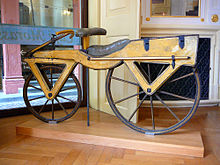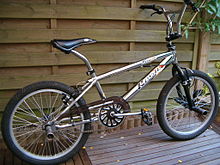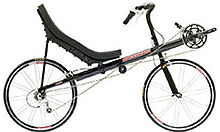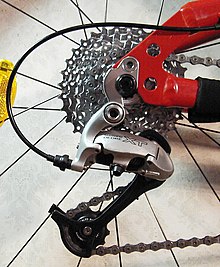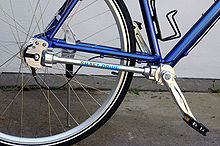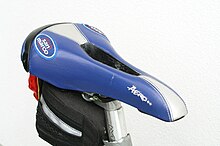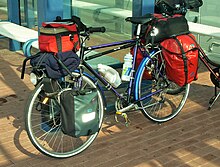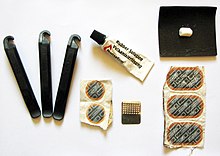Bicycles were introduced in the 19th century and now number about one billion worldwide, twice as many as automobiles.
[1] They are the principal
means of transportation in many regions. They also provide a popular form of recreation, and have been adapted for such uses as children's toys, adult fitness, military and police applications, courier services and
bicycle racing.
The basic shape and configuration of a typical
upright bicycle has changed little since the first chain-driven model was developed around 1885.
[2] However, many details have been improved, especially since the advent of modern materials and
computer-aided design. These have allowed for a proliferation of specialized designs for particular types of
cycling.
The invention of the bicycle has had an enormous impact on society, both in terms of culture and of advancing modern industrial methods. Several components that eventually played a key role in the development of the automobile were originally invented for the bicycle – e.g., ball bearings, pneumatic tires, chain-driven sprockets, spoke-tensioned wheels, etc.
History
Wooden
draisine (around 1820), the first two-wheeler and as such the archetype of the bicycle
Multiple innovators contributed to the history of the bicycle by developing precursor human-powered vehicles. The documented ancestors of today's modern bicycle were known as
draisines, hobby horses, or push bikes (and modern bicycles are sometimes still called push bikes outside of North America). Being the first human means of transport to make use of the two-wheeler principle, the draizine (or
Laufmaschine, "walking machine"), invented by the German
Baron Karl von Drais, is regarded as the forerunner of the modern bicycle. It was introduced by Drais to the public in
Mannheim in summer 1817 and in Paris in 1818.
[3] Its rider sat astride a wooden frame supported by two in-line wheels and pushed the vehicle along with his/her feet while steering the front wheel.
Michaux' son on velocipede 1868
Thomas McCall in 1869 on his velocipede
In the early 1860s, Frenchmen
Pierre Michaux and
Pierre Lallement took bicycle design in a new direction by adding a mechanical
crank drive with pedals on an enlarged front wheel (the
velocipede). Another French inventor by the name of Douglas Grasso had a failed prototype of Pierre Lallement's bicycle several years earlier. Several inventions followed using rear wheel drive, the best known being the rod-driven velocipede by Scotsman
Thomas McCall in 1869. The French creation, made of iron and wood, developed into the "
penny-farthing" (historically known as an "ordinary bicycle", a
retronym, since there was then no other kind).
[4] It featured a tubular steel frame on which were mounted wire-spoked wheels with solid rubber tires. These bicycles were difficult to ride due to their very high seat and poor
weight distribution.
Bicycle in
Plymouth, England at the start of the 20th century
The
dwarf ordinary addressed some of these faults by reducing the front wheel diameter and setting the seat further back. This necessitated the addition of gearing, effected in a variety of ways, to efficiently use the power available. However, having to both pedal and steer via the front wheel remained a problem.
J. K. Starley, J. H. Lawson, and Shergold solved this problem by introducing the
chain drive(originated by the unsuccessful "bicyclette" of Englishman Henry Lawson),
[5] connecting the frame-mounted cranks to the rear wheel. These models were known as
dwarf safeties, or
safety bicycles, for their lower seat height and better weight distribution. (Although without pneumatic tires the ride of the smaller wheeled bicycle would be much rougher than that of the larger wheeled variety.) Starley's 1885 Rover is usually described as the first recognizably modern bicycle. Soon, the
seat tube was added, creating the double-triangle
diamond frame of the modern bike.
Further innovations increased comfort and ushered in a second
bicycle craze, the 1890s'
Golden Age of Bicycles. In 1888, Scotsman
John Boyd Dunlop introduced the first practical
pneumatic tire, which soon became universal. Soon after, the rear
freewheel was developed, enabling the rider to coast. This refinement led to the 1905 invention of
coaster brakes.
Derailleur gears and hand-operated
cable-pull brakeswere also developed during these years, but were only slowly adopted by casual riders. By the turn of the century,
cycling clubs flourished on both sides of the Atlantic, and touring and racing became widely popular.
Bicycles and horse buggies were the two mainstays of private transportation just prior to the automobile, and the grading of smooth roads in the late 19th century was stimulated by the widespread advertising, production, and use of these devices.
Bicycles have been and are employed for many uses:
- Utility: bicycle commuting and utility cycling
- Work: mail delivery, paramedics, police, couriering, andgeneral delivery.
- Recreation: bicycle touring, mountain biking, BMX andphysical fitness.
- Racing: track racing, criterium, roller racing and time trial to multi-stage events like the Tour of California,Giro d'Italia, the Tour de France, the Vuelta a España, the Volta a Portugal, among others.
- Military: scouting, troop movement, supply of provisions, and patrol. See bicycle infantry.
- Show: entertainment and performance, e.g. circus clowns.
- As a novelty musical instrument; e.g. Frank Zappa and P. D. Q. Bach.
[edit]Technical aspects
The bicycle has undergone continual adaptation and improvement since its inception. These innovations have continued with the advent of modern materials and computer-aided design, allowing for a proliferation of specialized bicycle types.
Bicycles can be categorized in different ways: e.g. by function, by number of riders, by general construction, by gearing or by means of propulsion. The more common types include
utility bicycles,
mountain bicycles,
racing bicycles,
touring bicycles,
hybrid bicycles,
cruiser bicycles, and
BMX Bikes. Less common are
tandems,
lowriders,
tall bikes,
fixed gear,
folding models,
amphibious bicycles and
recumbents (one of which was used to set the
IHPVA Hour record).
Unicycles,
tricycles and
quadracycles are not strictly bicycles, as they have respectively one, three and four wheels, but are often referred to informally as "bikes".
Bicycles leaning in a turn
[edit]Dynamics
A bicycle stays upright while moving forward by being steered so as to keep its
center of gravityover the wheels.
[6] This steering is usually provided by the rider, but under certain conditions may be provided by the bicycle itself.
[7]The combined center of mass of a bicycle and its rider must lean into a turn to successfully navigate it. This lean is induced by a method known as
countersteering, which can be performed by the rider turning the handlebars directly with the hands
[8] or indirectly by leaning the bicycle.
[9]Short-wheelbase or
tall bicycles, when braking, can generate enough stopping force at the front wheel to flip longitudinally.
[10] The act of purposefully using this force to lift the rear wheel and balance on the front without tipping over is a trick known as a
stoppie, endo or front wheelie.
[edit]Performance
The bicycle is extraordinarily efficient in both biological and mechanical terms. The bicycle is the most efficient self-powered means of transportation in terms of energy a person must expend to travel a given distance.
[11] From a mechanical viewpoint, up to 99% of the energy delivered by the rider into the pedals is transmitted to the wheels, although the use of gearing mechanisms may reduce this by 10–15%.
[12][13] In terms of the ratio of cargo weight a bicycle can carry to total weight, it is also an efficient means of cargo transportation.
A human traveling on a bicycle at low to medium speeds of around 10–15 mph (15–25 km/h) uses only the energy required to walk. Air drag, which is proportional to the square of speed, requires dramatically higher power outputs as speeds increase. If the rider is sitting upright, the rider's body creates about 75% of the total drag of the bicycle/rider combination. Drag can be reduced by seating the rider in a
supine position or a
prone position, thus creating a
recumbent bicycle or
human powered vehicle. Drag can also be reduced by covering the bicycle with an aerodynamic
fairing.
In addition, the
carbon dioxide generated in the production and transportation of the food required by the bicyclist, per mile traveled, is less than 1/10th that generated by energy efficient cars.
[14][edit]Construction and parts
In its early years, bicycle construction drew on pre-existing technologies. More recently, bicycle technology has in turn contributed ideas in both old and new areas.
Main article:
Bicycle frameThe great majority of today's bicycles have a frame with upright seating which looks much like the first chain-driven bike.
[2] Such
upright bicycles almost always feature the
diamond frame, a
trussconsisting of two triangles: the front triangle and the rear triangle. The front triangle consists of the head tube, top tube, down tube and seat tube. The head tube contains the
headset, the set of bearings that allows the
fork to turn smoothly for steering and balance. The top tube connects the head tube to the seat tube at the top, and the down tube connects the head tube to the
bottom bracket. The rear triangle consists of the seat tube and paired chain stays and seat stays. The chain stays run parallel to the
chain, connecting the bottom bracket to the rear
dropouts. The seat stays connect the top of the seat tube (at or near the same point as the top tube) to the rear dropouts.
Historically, women's bicycle frames had a top tube that connected in the middle of the seat tube instead of the top, resulting in a lower
standover height at the expense of compromised structural integrity, since this places a strong bending load in the seat tube, and bicycle frame members are typically weak in bending. This design, referred to as a
step-through frame, allows the rider to mount and dismount in a dignified way while wearing a skirt or dress. While some women's bicycles continue to use this frame style, there is also a variation, the
mixte, which splits the top tube laterally into two thinner top tubes that bypass the seat tube on each side and connect to the rear dropouts. The ease of stepping through is also appreciated by those with limited flexibility or other joint problems. Because of its persistent image as a "women's" bicycle, step-through frames are not common for larger frames.
Another style is the
recumbent bicycle. These are inherently more
aerodynamic than upright versions, as the rider may lean back onto a support and operate pedals that are on about the same level as the seat. The world's fastest bicycle is a recumbent bicycle but this type was banned from competition in 1934 by the
Union Cycliste Internationale.
[15]Historically, materials used in bicycles have followed a similar pattern as in aircraft, the goal being high strength and low weight. Since the late 1930s alloy steels have been used for frame and fork tubes in higher quality machines.
Celluloid found application in mudguards, and
aluminum alloys are increasingly used in components such as handlebars,
seat post, and brake levers. In the 1980s aluminum alloy frames became popular for their lightness, and their affordability now makes them common. More expensive carbon fiber and titanium frames are now also available, as well as advanced steel alloys and even bamboo.
[16][edit]Drivetrain and gearing
A set of rear sprockets (also known as a cassette) and a derailleur
The
drivetrain begins with
pedals which rotate the
cranks, which are held in axis by the
bottom bracket. Most bicycles use a chain to transmit power to the rear wheel. A relatively small number of bicycles use a shaft drive to transmit power. A very small number of bicycles (mainly
single-speed bicycles intended for short-distance commuting) use a belt drive as an oil-free way of transmitting power.
Different gears and ranges of gears are appropriate for different people and styles of cycling. Multi-speed bicycles allow gear selection to suit the circumstances: a cyclist could use a high gear when cycling downhill, a medium gear when cycling on a flat road, and a low gear when cycling uphill. In a lower gear every turn of the pedals leads to fewer rotations of the rear wheel. This allows the energy required to move the same distance to be distributed over more pedal turns, reducing fatigue when riding uphill, with a heavy load, or against strong winds. A higher gear allows a cyclist to make fewer pedal turns to maintain a given speed, but with more effort per turn of the pedals.
With a
chain drive transmission, a
chainring attached to a crank drives the
chain, which in turn rotates the rear wheel via the rear
sprocket(s) (
cassette or
freewheel). There are four gearing options: two-speed hub gear integrated with chain ring, up to 3 chain rings, up to 11 sprockets, hub gear built in to rear wheel (3-speed to 14-speed). The most common options are either a rear hub or multiple chain rings combined with multiple sprockets (other combinations of options are possible but less common).
With a
shaft drive transmission, a gear set at the bottom bracket turns the shaft, which then turns the rear wheel via a gear set connected to the wheel's hub. There is some small loss of efficiency due to the two gear sets needed. The only gearing option with a shaft drive is to use a
hub gear.
[edit]Steering and seating
The
handlebars turn the
fork and the front wheel via the
stem, which rotates within the
headset. Three styles of handlebar are common.
Upright handlebars, the norm in Europe and elsewhere until the 1970s, curve gently back toward the rider, offering a natural grip and comfortable upright position.
Drop handlebars "drop" as they curve forward and down, offering the cyclist best braking power from a more aerodynamic "crouched" position, as well as more upright positions in which the hands grip the brake lever mounts, the forward curves, or the upper flat sections for increasingly upright postures. Mountain bikes generally feature a 'straight handlebar' or 'riser bar' with varying degrees of sweep backwards and centimeters rise upwards, as well as wider widths which can provide better handling due to increased leverage against the wheel.
A Selle San Marco saddle designed for women
Saddles also vary with rider preference, from the cushioned ones favored by short-distance riders to narrower saddles which allow more room for leg swings. Comfort depends on riding position. With comfort bikes and hybrids, cyclists sit high over the seat, their weight directed down onto the saddle, such that a wider and more cushioned saddle is preferable. For racing bikes where the rider is bent over, weight is more evenly distributed between the handlebars and saddle, the hips are flexed, and a narrower and harder saddle is more efficient. Differing saddle designs exist for male and female cyclists, accommodating the genders' differing anatomies, although bikes typically are sold with saddles most appropriate for men.
A recumbent bicycle has a reclined
chair-like seat that some riders find more comfortable than a saddle, especially riders who suffer from certain types of seat, back, neck, shoulder, or wrist pain. Recumbent bicycles may have either under-seat or over-seat
steering.
Modern bicycle
brakes may be:
rim brakes, in which friction pads are compressed against the wheel rims;
internal hub brakes, in which the friction pads are contained within the wheel hubs; or
disc brakes, with a separate rotor for braking.
Disc brakes are more common on off-road bicycles,
tandems and recumbent bicycles than on road-specific bicycles.
A front disc brake, mounted to the
forkand hub
With hand-operated brakes, force is applied to brake levers mounted on the handlebars and transmitted via
Bowden cables or hydraulic lines to the friction pads. A rear hub brake may be either hand-operated or pedal-actuated, as in the back pedal
coaster brakes which were popular in North America until the 1960s, and are common in children's bicycles.
Track bicycles do not have dedicated brakes. Brakes are not required for riding on a track because all riders ride in the same direction around a track which does not necessitate sharp deceleration. Track riders are still able to slow down because all track bicycles are
fixed-gear, meaning that there is no
freewheel. Without a freewheel, coasting is impossible, so when the rear wheel is moving, the crank is moving. To slow down, the rider applies resistance to the pedals – this acts as a braking system which can be as effective as a friction-based rear wheel brake, but not as effective as a front wheel brake.
[17] [edit]Suspension
Bicycle suspension refers to the system or systems used to suspend the rider and all or part of the bicycle. This serves two purposes:
- To keep the wheels in continuous contact with rough surfaces to improve control.
- To isolate the rider and luggage from jarring due to rough surfaces.
Bicycle suspensions are used primarily on mountain bicycles, but are also common on hybrid bicycles, and can even be found on some road bicycles, as they can help deal with problematic vibration. Suspension is especially important on recumbent bicycles, since while an upright bicycle rider can stand on the pedals to achieve some of the benefits of suspension, a recumbent rider cannot.
[edit]Wheels and tires
Main article:
Bicycle wheelThe wheel axle fits into
dropouts in the
frame and
forks. A pair of wheels may be called a
wheelset, especially in the context of ready-built "off the shelf", performance-oriented wheels.
Main article:
Bicycle tireTires vary enormously. Skinny 18 to 25 millimeters wide, road-racing tires may be completely smooth, or (
slick). On the opposite extreme, off-road tires are 38 to 64 millimeters wide and usually have a deep tread for gripping in muddy conditions or metal studs for ice.
[edit]Accessories, repairs, and tools
Touring bicycle equipped with
head lamp,
pump, rear
rack, fenders/mud-guards, water bottles and
cages, and numerous saddle-bags.
Puncture repair kit with tire levers, sandpaper to clean off an area of the inner tube around the puncture, a tube of rubber solution (vulcanizing fluid), round and oval patches, a metal grater and piece of chalk to make chalk powder (to dust over excess rubber solution). Kits often also include a wax crayon to mark the puncture location.
Some components, which are often optional accessories on sports bicycles, are standard features on
utility bicycles to enhance their usefulness and comfort.
Mudguards, or
fenders, protect the cyclist and
moving parts from spray when riding through wet areas and
chainguards protect clothes from oil on the chain while preventing clothing from being caught between the chain and
crankset teeth.
Kick stands keep a bicycle upright when parked, while a
bike lock will help prevent it from being stolen. Front-mounted
baskets for carrying goods are often used.
Luggage carriersand
panniers mounted above the rear tire can be used to carry equipment or cargo. Parents sometimes add rear-mounted
child seats and/or an auxiliary saddle fitted to the crossbar to transport children.
Toe-clips and
toestraps and
clipless pedals help keep the foot locked in the proper position on the pedals, and enable the cyclist to pull as well as push the pedals—although not without their hazards, e.g. may lock foot in when needed to prevent a fall. Technical accessories include
cyclocomputers for measuring speed, distance, heart rate, GPS data etc. Other accessories include
lights, reflectors,
security locks, mirror, water bottles and
cages, and bell.
[18] Bicycle helmets may help reduce injury in the event of a collision or accident, and a certified helmet is legally required for some riders in some jurisdictions. Helmets are classified as an accessory
[18] or an item of clothing by others.
[19] Many cyclists carry
tool kits. These may include a tire patch kit (which, in turn, may contain any combination of a
hand pump or
CO2 Pump,
tire levers, spare
tubes, self-adhesive patches, or tube-patching material, an adhesive, a piece of sandpaper or a metal grater (for roughing the tube surface to be patched),
[20][21] and sometimes even a block of
French chalk.),
wrenches,
hex keys,
screwdrivers, and a
chain tool. There are also cycling specific
multi-tools that combine many of these implements into a single compact device. More specialized bicycle components may require more complex tools, including proprietary tools specific for a given manufacturer.
Some bicycle parts, particularly hub-based gearing systems, are complex, and many cyclists prefer to leave
maintenance and repairs to professional
bicycle mechanics. In some areas it is possible to purchase road-side assistance from companies such as the
Better World Club. Other cyclists maintain their own bicycles, perhaps as part of their enjoyment of the hobby of cycling or simply for economic reasons. The ability to repair and maintain your own bicycle is also celebrated within the
DIY movement.
[edit]Standards
A number of formal and industry standards exist for bicycle components to help make spare parts exchangeable and to maintain a minimum product safety.
The
International Organization for Standardization,
ISO, has a special technical committee for cycles, TC149, that has the following scope: "Standardization in the field of cycles, their components and accessories with particular reference to terminology, testing methods and requirements for performance and safety, and interchangeability."
CEN, European Committee for Standardisation, also has a specific Technical Committee, TC333, that defines European standards for cycles. Their mandate states that EN cycle standards shall harmonize with
ISO standards. Some CEN cycle standards were developed before ISO published their standards, leading to strong European influences in this area. European cycle standards tend to describe minimum safety requirements, while ISO standards have historically harmonized parts geometry.
[22] [edit]Social and historical aspects
The bicycle has had a considerable effect on human society, in both the cultural and industrial realms.
[edit]In daily life
Around the turn of the 20th century, bicycles reduced crowding in inner-city tenements by allowing workers to
commute from more spacious dwellings in the suburbs. They also reduced dependence on horses. Bicycles allowed people to travel for leisure into the country, since bicycles were three times as energy efficient as walking and three to four times as fast.
Recently, several European cities and
Montreal have implemented successful schemes known as
community bicycle programs or bike-sharing. These initiatives complement a city's public transport system and offer an alternative to motorized traffic to help reduce congestion and pollution. In Europe, especially in The Netherlands and parts of Germany and Denmark,
commuting by bicycle is very common. In the Danish capital of
Copenhagen, a cyclists' organization runs a
Cycling Embassy, that promotes biking for commuting and sightseeing. In the UK there's a tax break scheme (IR 176) that allows employees to buy a new bicycle tax free to use for commuting.
[citation needed]In The Netherlands, all train stations are equipped with provisions for bicycle parking for a small fee and the larger ones also with bicycle repair shops, and cycling is so popular that the parking capacity is sometimes exceeded.
[23] In
Trondheim in Norway, the
Trampe bicycle lift has been developed to encourage cyclists by giving assistance on a steep hill.
In cities where the bicycle is not an integral part of the planned transportation system, commuters often use bicycles as elements of a
mixed-mode commute, where the bike is used to travel to and from train stations or other forms of rapid transit.
Folding bicycles are useful in these scenarios, as they are less cumbersome when carried aboard. Los Angeles removed a small amount of seating on some trains to make more room for bicycles and wheel chairs.
[24]Bicycles offer an important mode of transport in many developing countries. Until recently, bicycles have been a staple of everyday life throughout Asian countries. They are the most frequently used method of transport for commuting to work, school, shopping, and life in general.
[citation needed][edit]Female emancipation
Woman with bicycle, 1890s
The
safety bicycle gave women unprecedented mobility, contributing to
their emancipation in Western nations. As bicycles became safer and cheaper, more women had access to the personal freedom they embodied, and so the bicycle came to symbolize the
New Woman of the late 19th century, especially in Britain and the United States. The bicycle was recognized by 19th-century
feminists and
suffragists as a "freedom machine" for women. American
Susan B. Anthonysaid in a
New York World interview on February 2, 1896: "Let me tell you what I think of bicycling. I think it has done more to emancipate women than anything else in the world. It gives women a feeling of freedom and self-reliance. I stand and rejoice every time I see a woman ride by on a wheel...the picture of free, untrammeled womanhood." In 1895 Frances Willard, the tightly laced president of the
Women’s Christian Temperance Union, wrote a book called
How I Learned to Ride the Bicycle, in which she praised the bicycle she learned to ride late in life, and which she named "Gladys", for its "gladdening effect" on her health and political optimism. Willard used a cycling metaphor to urge other suffragists to action, proclaiming, "I would not waste my life in friction when it could be turned into momentum."
The
bicycle craze in the 1890s also led to a movement for so-called
rational dress, which helped liberate women from corsets and ankle-length skirts and other restrictive garments, substituting the then-shocking
bloomers.
[edit]Economic implications
Bicycle manufacturing proved to be a training ground for other industries and led to the development of advanced metalworking techniques, both for the frames themselves and for special components such as
ball bearings,
washers, and
sprockets. These techniques later enabled skilled metalworkers and mechanics to develop the components used in early automobiles and aircraft.
They also served to teach the industrial models later adopted, including mechanization and
mass production (later copied and adopted by
Ford and
General Motors),
[25] vertical integration
[26] (also later copied and adopted by Ford), aggressive advertising
[27] (as much as 10% of all advertising in U.S. periodicals in 1898 was by bicycle makers),
[28] lobbying for better roads (which had the side benefit of acting as advertising, and of improving sales by providing more places to ride),
[29] all first practised by Pope.
[29] In addition, bicycle makers adopted the annual model change
[30][31] (later derided as
planned obsolescence, and usually credited to General Motors), which proved very successful.
[32]Furthermore, early bicycles were an example of
conspicuous consumption, being adopted by the fashionable elites.
[33] In addition, by serving as a platform for accessories, which could ultimately cost more than the bicycle itself, it paved the way for the likes of the
Barbie doll.
[34]Moreover, they helped create, or enhance, new kinds of businesses, such as bicycle messengers,
[35] travelling seamstresses,
[36] riding academies,
[37] and racing rinks
[38] (Their board tracks were later adapted to early
motorcycle and
automobile racing.) Also, there were a variety of new inventions, such as spoke tighteners,
[39] and specialized lights,
[40] socks and shoes,
[41] and even cameras (such as the
Eastman Company's
Poco).
[42] Probably the best known and most widely used of these inventions, adopted well beyond cycling, is Charles Bennett's Bike Web, which came to be called the "
jock strap".
[43]They also presaged a move away from public transit
[44] that would explode with the introduction of the automobile.
J. K. Starley's company became the Rover Cycle Company Ltd. in the late 1890s, and then simply the
Rover Company when it started making cars. The
Morris Motor Company (in
Oxford) and
Škoda also began in the bicycle business, as did the
Wright brothers.
[45] Alistair Craig, whose company eventually emerged to become the engine manufacturers
Ailsa Craig, also started from manufacturing bicycles, in Glasgow in March 1885.
In general, U.S. and European cycle manufacturers used to assemble cycles from their own frames and components made by other companies, although very large companies (such as Raleigh) used to make almost every part of a bicycle (including bottom brackets, axles, etc.) In recent years, those bicycle makers have greatly changed their methods of production. Now, almost none of them produce their own frames.
Many newer or smaller companies only design and market their products; the actual production is done by Asian companies. For example, some 60% of the world's bicycles are now being made in China. Despite this shift in production, as nations such as
China and
India become more wealthy, their own use of bicycles has declined due to the increasing affordability of cars and motorcycles.
[46] One of the major reasons for the proliferation of Chinese-made bicycles in foreign markets is the lower cost of labor in China.
[47]One of the profound economic implications of bicycle use is that it liberates the user from oil consumption (Ballantine, 1972). The bicycle is a inexpensive, fast, healthy and environmentally friendly mode of transport (Illich, 1974)
[edit]Legal requirements
Reflectors for riding after dark
Early in its development, as with
automobiles, there were restrictions on the operation of bicycles. Along with advertising, and to gain free publicity,
Albert A. Pope litigated on behalf of cyclists.
[48]The 1968
Vienna Convention on Road Traffic of the
United Nations considers a bicycle to be a vehicle, and a person controlling a bicycle (whether actually riding or not) is considered an operator. The traffic codes of many countries reflect these definitions and demand that a bicycle satisfy certain legal requirements before it can be used on public roads. In many
jurisdictions, it is an offense to use a bicycle that is not in a roadworthy condition.
In most jurisdictions, bicycles must have functioning front and rear lights when ridden after dark. As some generator or
dynamo-driven lamps only operate while moving, rear
reflectors are frequently also mandatory. Since a moving bicycle makes little noise, some countries insist that bicycles have a warning bell for use when approaching pedestrians, equestrians, and other cyclists.
Some countries require child and/or adult cyclists to wear
helmets, as this may protect riders from head trauma. Countries which require adult cyclists to wear helmets include Spain, Canada,
New Zealand and Australia.
[edit]See also
This audio file was created from a revision of
Bicycle dated 2007-12-07, and does not reflect subsequent edits to the article. (
Audio help)
General
Women on bicycles on unpaved road,
USA, late 19th Century
Special uses and related vehicle types
Other
- ^ DidYouKnow.org. There are about a billion or more bicycles in the world. Retrieved 30 July 2006.
- ^ a b Herlihy, David V. (2004). Bicycle: the history. Yale University Press. pp. 200–250. ISBN 0-300-10418-9.
- ^ "Canada Science and Technology Museum: Baron von Drais’ Bicycle". 2006. Retrieved 2006-12-23.
- ^ Norcliffe, Glen. The Ride to Modernity: The Bicycle in Canada, 1869-1900 (Toronto: University of Toronto Press, 2001), p.50, citing Derek Roberts.
- ^ Norcliffe, p.47.
- ^ Various (9 December 2006). "Like falling off". New Scientist (2581): 93. Retrieved 27 January 2009.
- ^ Meijaard, Papadopoulos, Ruina, and Schwab, J.P.; Papadopoulos, Jim M.; Ruina, Andy; Schwab, A.L. (2007). "Linearized dynamics equations for the balance and steer of a bicycle: a benchmark and review". Proc. R. Soc. A. 463 (2084): 1955–1982. doi:10.1098/rspa.2007.1857.
- ^ Wilson, David Gordon; Jim Papadopoulos (2004). Bicycling Science (Third ed.). The MIT Press. pp. 270–272. ISBN 0-262-73154-1.
- ^ Fajans, Joel (July 2000). "Steering in bicycles and motorcycles" (PDF). American Journal of Physics 68 (7): 654–659.doi:10.1119/1.19504. Retrieved 2006-08-04.
- ^ Cossalter, Vittore (2006). Motorcycle Dynamics (Second ed.). Lulu.com. pp. 241–342. ISBN 978-1-4303-0861-4.
- ^ "Bicycle Technology", S.S. Wilson, Scientific American, March 1973
- ^ "Johns Hopkins Gazette", 30 August 1999
- ^ Whitt, Frank R.; David G. Wilson (1982). Bicycling Science (Second ed.). Massachusetts Institute of Technology. pp. 277–300. ISBN 0-262-23111-5.
- ^ How Much Do Bicycles Pollute? Looking at the Carbon Dioxide Produced by Bicycles
- ^ History Loudly Tells Why The Recumbent Bike Is Popular Today
- ^ Lukenbill, Jen (13 February 2008). "Bamboo bikes". AboutMyPlanet.com.
- ^ Brown, Sheldon. "Fixed Gear Conversions: Braking". Retrieved 2009-02-11.
- ^ a b Bluejay, Michael. "Safety Accessories". Bicycle Accessories. BicycleUniverse.info. Retrieved 2006-09-13.
- ^ "The Essentials of Bike Clothing". About Bicycling. About.com. Retrieved 2006-09-13.
- ^ "Sheldon Brown: Flat tires". Retrieved 2008-05-29.
- ^ "BikeWebSite: Bicycle Glossary – Patch kit". Retrieved 2008-06-20.
^ The TC149 ISO bicycle committee, including the TC149/SC1 ("Cycles and major sub-assemblies") subcommittee, has published the following standards:
- ISO 4210 Cycles—Safety requirements for bicycles
- ISO 6692 Cycles—Marking of cycle components
- ISO 6695 Cycles—Pedal axle and crank assembly with square end fitting—Assembly dimensions
- ISO 6696 Cycles—Screw threads used in bottom bracket assemblies
- ISO 6697 Cycles—Hubs and freewheels—Assembly dimensions
- ISO 6698 Cycles—Screw threads used to assemble freewheels on bicycle hubs
- ISO 6699 Cycles—Stem and handlebar bend—Assembly dimensions
- ISO 6701 Cycles—External dimensions of spoke nipples
- ISO 6742 Cycles—Lighting and retro-reflective devices—Photometric and physical requirements
- ISO 8090 Cycles—Terminology (same as BS 6102-4)
- ISO 8098 Cycles—Safety requirements for bicycles for young children
- ISO 8488 Cycles—Screw threads used to assemble head fittings on bicycle forks
- ISO 8562 Cycles—Stem wedge angle
- ISO 10230 Cycles—Splined hub and sprocket—Mating dimensions
- ISO 11243 Cycles—Luggage carriers for bicycles—Concepts, classification and testing
Other ISO Technical Committees have published various cycle relevant standards, for example:
- ISO 5775 Bicycle tire and rim designations
- ISO 9633 Cycle chains—Characteristics and test methods
Published cycle standards from
CEN TC333 include:
- EN 14764 City and trekking bicycles – Safety requirements and test methods
- EN 14765 Bicycles for young children – Safety requirements and test methods
- EN 14766 Mountain-bicycles – Safety requirements and test methods
- EN 14781 Racing bicycles – Safety requirements and test methods
- EN 14782 Bicycles – Accessories for bicycles – Luggage carriers
- EN 15496 Cycles – Requirements and test methods for cycle locks
Yet to be approved cycle standards from
CEN TC333:
- EN 15194 Cycles—Electrically power assisted cycles (EPAC bicycle)
- EN 15532 Cycles—Terminology
- 00333011 Cycles – Bicycles trailers – safety requirements and test methods
- ^ Joel Broekaert and Reinier Kist (12 February 2010). "So many bikes, so little space". NRC Handelsblad. Retrieved 2010-02-13.
- ^ Damien Newton (October 16, 2008). "Metro Making Room for Bikes on Their Trains". LA.StreetsBlog.Org. Retrieved 2010-02-12.
- ^ Norcliffe, Glen. The Ride to Modernity: The Bicycle in Canada, 1869-1900 (Toronto: University of Toronto Press, 2001), pp.23, 106, & 108. GM's practice of sharing chassis, bodies, and other parts is exactly what the early bicycle manufacturer Pope was doing.
- ^ Norcliffe, p.106.
- ^ Norcliffe, pp.142–47.
- ^ Norcliffe, p.145.
- ^ a b Norcliffe, p.108.
- ^ Norcliffe, p.23.
- ^ Babaian, Sharon. The Most Benevolent Machine: A Historical Assessment of Cycles in Canada (Ottawa: National Museum of Science and Technology, 1998), p.97.
- ^ Babaian, p.98.
- ^ Norcliffe, pp.8, 12, 14, 23, 147–8, 187–8, 208, & 243–5.
- ^ Norcliffe, pp.23, 121, & 123.
- ^ Norcliffe, p.212.
- ^ Norcliffe, p.214.
- ^ Norcliffe, p.131.
- ^ Norcliffe, p.30 & 131.
- ^ Norcliffe, p.125.
- ^ Norcliffe, p.123 & 125.
- ^ Norcliffe, p.125 & 126.
- ^ Norcliffe, p.238.
- ^ Norcliffe, p.128.
- ^ Norcliffe, p.214–5.
- ^ "The Wrights' bicycle shop". 2007. Retrieved 2007-02-05.
- ^ Francois Bougo (May 26, 2010). "Beijing looks to revitalise bicycle culture". Agence France-Presse.
- ^ The Economist, 15 February 2003
- ^ Norcliffe, Glen. The Ride to Modernity: The Bicycle in Canada, 1869-1900 (Toronto: University of Toronto Press, 2001), p.108.
[edit]References
- All About Bicycling, Rand McNally.
- Richard Ballantine, Richard's Bicycle Book, Pan, 1975.
- Caunter C. F. The History and Development of Cycles Science Museum London 1972.
- Daniel Kirshner. Some nonexplanations of bicycle stability. American Journal of Physics, 48(1), 1980. The abstract reads "In this paper we attempt to verify a nongyroscopic theory of bicycle stability, and fail".
- David B. Perry, Bike Cult: the Ultimate Guide to Human-powered Vehicles, Four Walls Eight Windows, 1995.
- Roni Sarig, The Everything Bicycle Book, Adams Media Corporation, 1997
- "Randonneurs USA". PBP: Paris-Brest-Paris. March 31, 2005.
- US Department of Transportation, Federal Highway Administration. "America's Highways 1776-1976", pp. 42–43. Washington, DC, US Government Printing Office.
- David Gordon Wilson, Bicycling Science, MIT press, ISBN 0-262-73154-1
- David V. Herlihy, Bicycle: The History, Yale University Press, 2004
- Frank Berto, The Dancing Chain: History and Development of the Derailleur Bicycle, San Francisco: Van der Plas Publications, 2005,ISBN 1-892495-41-4.
- The Data Book: 100 Years of Bicycle Component and Accessory Design, San Francisco: Van der Plas Publications, 2005, ISBN 1-892495-01-5.
- "Bicycle facts". Retrieved 2006-07-25.



